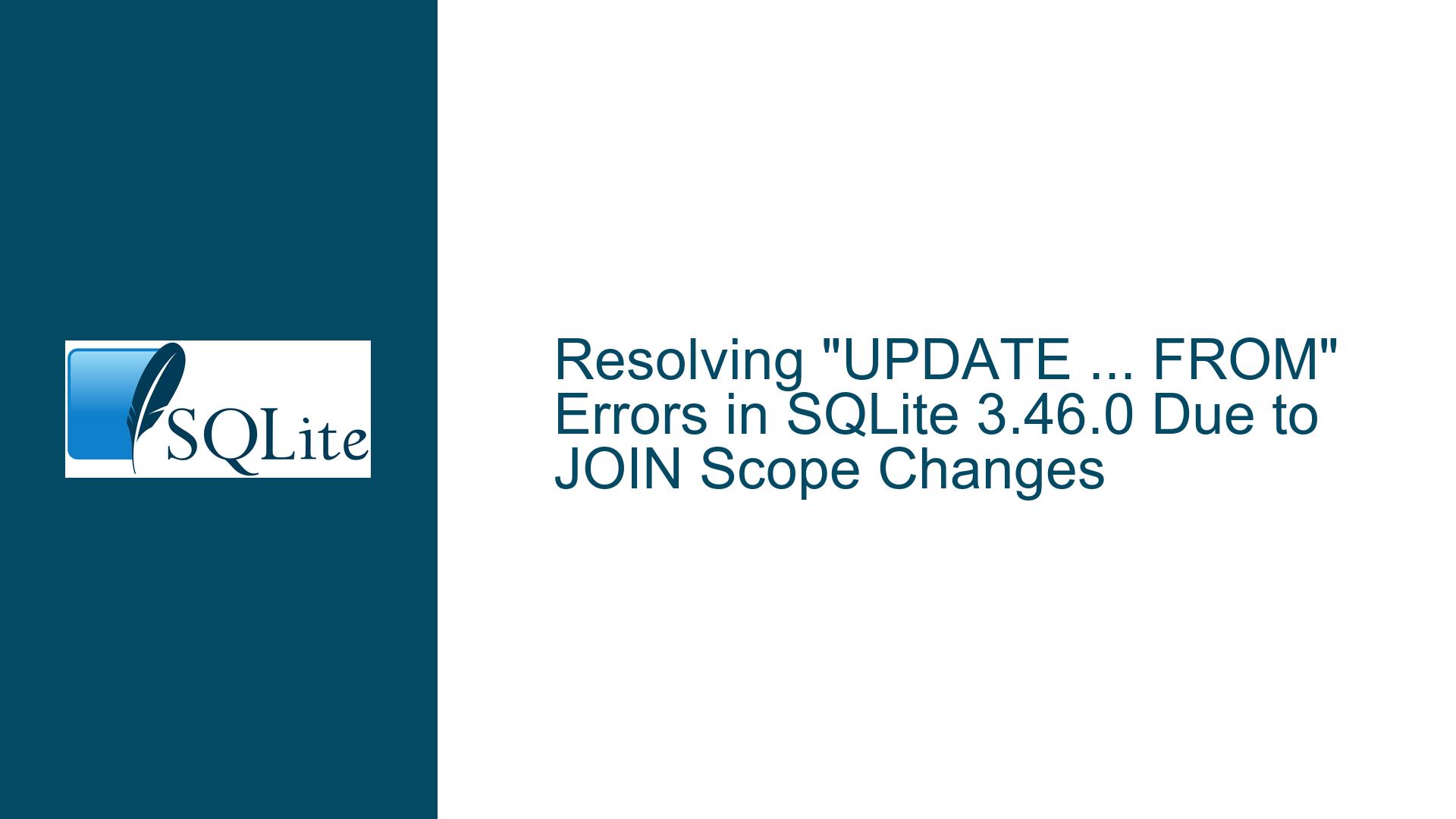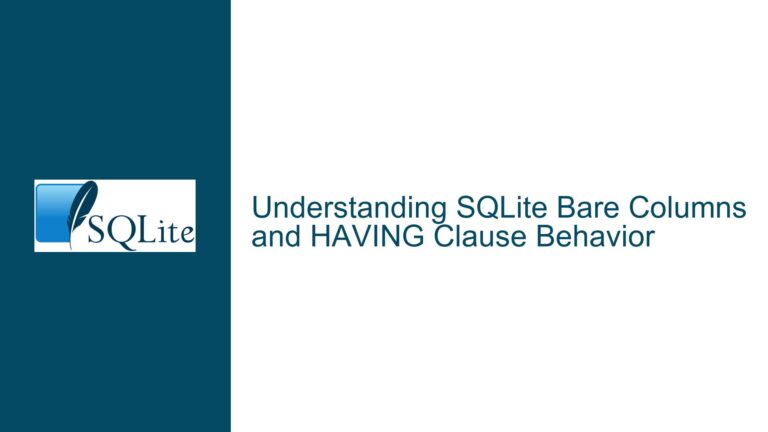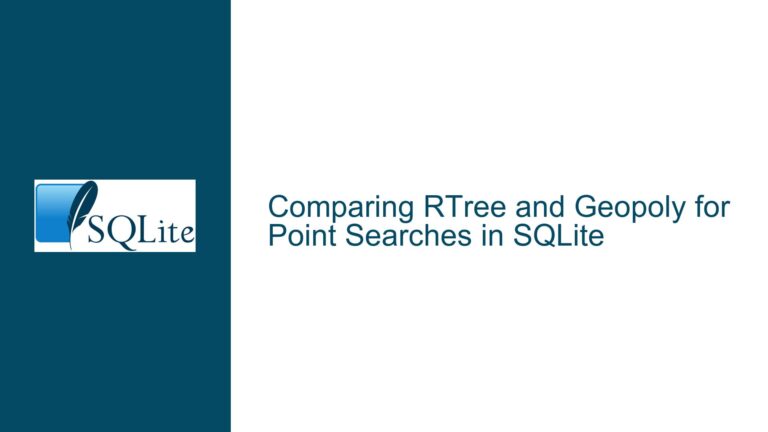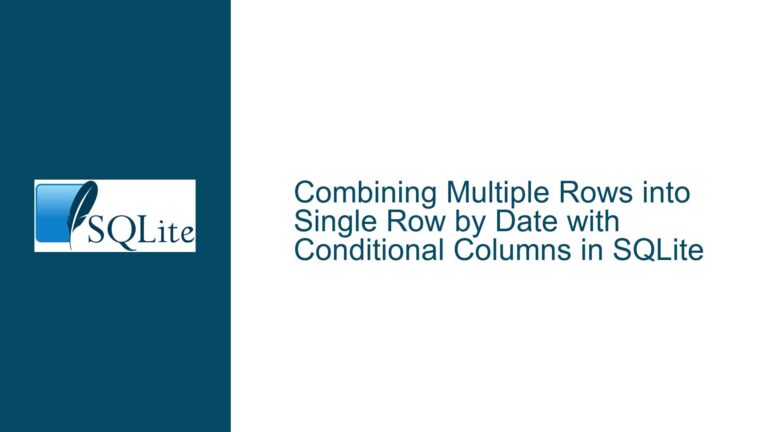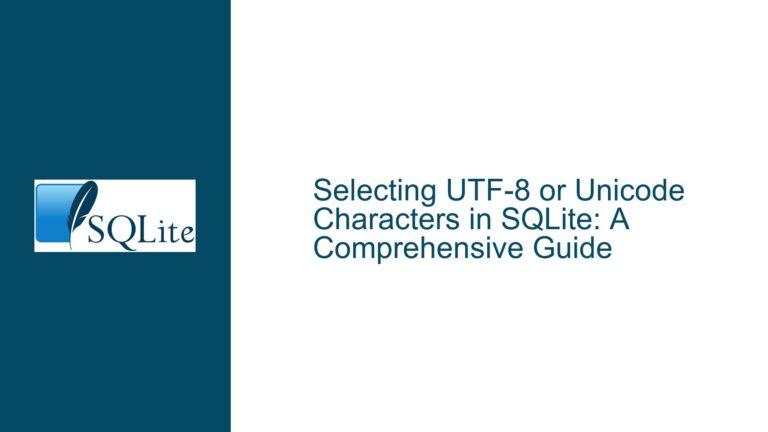Resolving “UPDATE … FROM” Errors in SQLite 3.46.0 Due to JOIN Scope Changes
Understanding Column Resolution Failures in UPDATE … FROM with JOIN Clauses
Issue Overview: Column Visibility in JOIN Clauses After SQLite 3.39.0
The core problem revolves around a change in SQLite’s handling of UPDATE ... FROM queries involving JOIN clauses, particularly when referencing columns from the target table (the table being updated) within the ON conditions of the JOIN. Starting with SQLite 3.39.0 (specifically after check-in 98b3816bbaf539ea), the parser aligns more closely with PostgreSQL’s scoping rules for UPDATE ... FROM statements.
In earlier SQLite versions (pre-3.39.0), the FROM clause of an UPDATE statement allowed direct references to columns of the target table within JOIN conditions. For example:
UPDATE t1 SET col = val
FROM t2
INNER JOIN t3 ON t2.id = t1.id; -- t1.id references the target table
This worked because SQLite treated the entire FROM clause (including JOIN conditions) as part of the same scope as the target table. However, after the change, SQLite now treats the FROM clause as a subquery, isolating its scope. This means columns from the target table are no longer visible in JOIN ... ON clauses, leading to errors like no such column: aarb_sku when the parser cannot resolve column names that belong to the target table.
The error arises specifically in queries where:
- The
UPDATEstatement usesFROMwithINNER JOIN,LEFT JOIN, or other explicit join types. - The
ONclause of the join references a column from the target table (the table being updated). - The SQLite version is 3.39.0 or newer.
For instance, the user’s original query:
UPDATE pim_art_arb_cat
SET aarb_arbo = CASE ...
FROM pim_a_p_dec
INNER JOIN pim_pro_arb_cat
ON apdec_sku_pere = parb_sku
AND apdec_sku_fils = aarb_sku; -- aarb_sku is from pim_art_arb_cat
Fails because aarb_sku belongs to pim_art_arb_cat (the target table), which is not visible in the isolated FROM subquery.
Root Causes: Scoping Changes and Compatibility Adjustments
The issue stems from two interrelated factors:
SQLite’s PostgreSQL Compatibility Shift
The 3.39.0 update adjustedUPDATE ... FROMbehavior to match PostgreSQL’s scoping rules. In PostgreSQL, theFROMclause in anUPDATEis evaluated as an independent subquery, preventing references to the target table’s columns withinJOINconditions. This change was intended to improve cross-database compatibility but introduced breaking changes for existing SQLite queries that relied on the older scoping behavior.Ambiguity in Column Resolution
When theFROMclause is parsed as a subquery, the parser resolves column names only against the tables listed in theFROMandJOINclauses. Columns from the target table are excluded from this resolution process. For example, in the query above:apdec_sku_pereandparb_skuare resolved topim_a_p_decandpim_pro_arb_cat, respectively.aarb_sku(frompim_art_arb_cat) is invisible to theJOINsubquery, causing a "no such column" error.
Implicit vs. Explicit Joins
SQLite historically allowed comma-style implicit joins (e.g.,FROM t1, t2 WHERE t1.id = t2.id) and explicit joins (e.g.,FROM t1 INNER JOIN t2 ON t1.id = t2.id) to behave identically. However, the scoping change applies only to explicit joins. Comma-style joins in theFROMclause still allow references to the target table’s columns in theWHEREclause, creating an inconsistency.
Solutions: Query Rewrites, Schema Adjustments, and Best Practices
To resolve the error, you must restructure the query to comply with the new scoping rules. Below are actionable fixes, ordered by practicality:
1. Replace JOIN … ON with Comma-Style Joins and WHERE Clauses
Rewrite the query to use implicit joins (comma-separated tables) and move conditions from the ON clause to the WHERE clause. This leverages the fact that the WHERE clause operates in the outer scope, where the target table’s columns are visible.
Original Query (Failing):
UPDATE pim_art_arb_cat
SET aarb_arbo = CASE ...
FROM pim_a_p_dec
INNER JOIN pim_pro_arb_cat
ON apdec_sku_pere = parb_sku
AND apdec_sku_fils = aarb_sku; -- Error: aarb_sku not found
Revised Query (Working):
UPDATE pim_art_arb_cat
SET aarb_arbo = CASE ...
FROM pim_a_p_dec, pim_pro_arb_cat
WHERE apdec_sku_pere = parb_sku
AND apdec_sku_fils = aarb_sku; -- Valid: WHERE sees target table
Why This Works:
- The comma-style join places
pim_a_p_decandpim_pro_arb_catin theFROMsubquery. - The
WHEREclause operates in the outer scope, allowing access toaarb_skufrompim_art_arb_cat.
2. Use Subqueries or CTEs to Isolate JOIN Logic
If retaining explicit joins is critical, encapsulate the join logic in a subquery or CTE (Common Table Expression) and reference the target table in the outer query.
Example with CTE:
WITH joined_data AS (
SELECT
pim_a_p_dec.*,
pim_pro_arb_cat.parb_sku
FROM pim_a_p_dec
INNER JOIN pim_pro_arb_cat
ON apdec_sku_pere = parb_sku
)
UPDATE pim_art_arb_cat
SET aarb_arbo = CASE ...
FROM joined_data
WHERE apdec_sku_fils = aarb_sku;
Benefits:
- The
JOINis confined to the CTE, avoiding references to the target table. - The
WHEREclause in the outer query safely referencesaarb_sku.
3. Alias the Target Table and Reference It Explicitly
While not always sufficient, aliasing the target table can sometimes clarify column references. However, this is more effective in WHERE clauses than in JOIN ... ON clauses under the new rules.
Example:
UPDATE pim_art_arb_cat AS target
SET aarb_arbo = CASE ...
FROM pim_a_p_dec
INNER JOIN pim_pro_arb_cat
ON apdec_sku_pere = parb_sku
AND apdec_sku_fils = target.aarb_sku; -- Still fails in JOIN ... ON
Outcome:
- This will still fail because the
JOIN ... ONclause cannot referencetarget.aarb_sku(the subquery isolation applies). - Move the condition to the
WHEREclause:UPDATE pim_art_arb_cat AS target SET aarb_arbo = CASE ... FROM pim_a_p_dec, pim_pro_arb_cat WHERE apdec_sku_pere = parb_sku AND apdec_sku_fils = target.aarb_sku; -- Valid
4. Downgrade SQLite (Temporary Workaround)
If query rewriting is impractical, reverting to SQLite ≤3.38.5 restores the old scoping behavior. However, this is not recommended long-term, as it forfeits security patches and newer features.
5. Review Schema for Ambiguous Column Names
While not the primary issue here, ambiguous column names can exacerbate scoping problems. Ensure all columns in JOIN conditions are fully qualified (e.g., table.column).
Example:
UPDATE pim_art_arb_cat
SET aarb_arbo = CASE ...
FROM pim_a_p_dec
INNER JOIN pim_pro_arb_cat
ON pim_a_p_dec.apdec_sku_pere = pim_pro_arb_cat.parb_sku
WHERE pim_a_p_dec.apdec_sku_fils = pim_art_arb_cat.aarb_sku;
Final Recommendations:
- Prefer Comma-Style Joins: Use implicit joins with
WHEREclauses forUPDATE ... FROMqueries involving the target table’s columns. - Test Across Versions: Validate queries against multiple SQLite versions if cross-version compatibility is required.
- Monitor SQLite Changelogs: Stay informed about parser adjustments, especially around
UPDATE ... FROMand join semantics.
By restructuring queries to align with the new scoping rules, you can maintain compatibility with modern SQLite versions while avoiding runtime errors.
